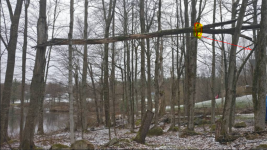Jaylegger
Platinum Member
- Joined
- Oct 4, 2009
- Messages
- 713
- Tractor
- Massey Ferguson GC2600L
Load up the shotgun and have at it.
If it was me I壇 pick that triple topped tree to domino into the top of the other shooting for about where the red circle is. Now setting up something like this need to be done correctly use a humboldt face and a full face Dutchman with an extra kicker on the stump to try and get the butt on the ground fast as well as hard for extra force.View attachment 655089
I have done stuff like this well falling timber it works but you need to be confident in your skills as well as getting out of the line of fire at the right time.
that's why they make feller/bunchers!..I致e also seen this happen when using equipment, an excavator isn稚 a forestry machine there痴 no structure to protect the operator in the case of a limb or tree come down on the cab. Now to the falling how close you cut your pusher tree plays a huge roll in how the butt will act as well as how the face is done.
Load up the shotgun and have at it.
that's why they make feller/bunchers!..

He may not be but it痴 still a safer alternative then standing on a ladder or B pulling on a line, rope, or a chain that could snap sending a while or shrapnel at the back of him or his face. I do agree he more then likely doesn稚 have the skills to do a job like this but something done from the ground is possible.
I need to start clearing some land, but the first thing I need to tackle is this wind damaged tree that has been hanging out like this for about 5 years.
Any suggestions on a safe way to get it down?View attachment 655037
View attachment 655407
I'll try one last time...Running bowline where the red circle is and pull in the direction of the arrow (same direction the top is facing, not against the trees holding it up) from at least 50'-75' away with an arborist rope 5/8" or larger. Do not ever stand under it to notch another tree with pressure on it. They call them widow makers for a reason. Even experienced arborists have difficulty assessing the different loads due to so many variables. Do not ever stand on a ladder and use a chainsaw without an overhead lifeline.
My opinion is you have 3 options:
1. hire it out (safest)
2. use the same amount of money to invest in gear to do it safely (and have it for future use)
TreeStuff - Samson 3/4" Stable Braid Bull Rope
TreeStuff - • Notch Acculine and Throw Weight Combo Kit
3. shoot it down (most fun)
To option 2, I would add get yourself some training to learn how to use that gear safely. There is a lot more to doing this safely than just having a strong rope and something powerful to pull on it. If I had to choose between knowledge and gear, I'd pick knowledge almost every time - even if sometimes it's just the knowledge that "this is just too much for me. It's time to call a friend or call a pro."
you can't get nukes, but there's a lot of military collectors around that have almost everything, and if they have an FFL, they can have the main gun firing on the tank, too!!..Some surplus Soviet ordanance. Hey, maybe a battlefield NUKE!
If the thread goes any longer, the tree will simply rot and fall down on it's own.
or just rent a military tank, and pull it or push it down with that, this is the safest option, without any danger!..
Some surplus Soviet ordanance. Hey, maybe a battlefield NUKE!
you can't get nukes, but there's a lot of military collectors around that have almost everything, and if they have an FFL, they can have the main gun firing on the tank, too!!..
As we look at that picture, ultimately how many of the trees we are looking at will be taken out? If that entire area will be cleared it would change the way I would tackle it.
Doug in SW IA